Abstract
The early observations of an apparent anomalous action of acetylcholine on the regulation of vascular tone in vivo and in vitro were found to be a reflection of the intactness of the endothelium in vivo. An intact endothelium mediates relaxation of smooth muscle in response to acetylcholine, whereas endothelium-denuded blood vessels exposed to this agonist often exhibit vasoconstriction. The vasodilation is mediated by the actions of the endothelium-derived relaxing factors nitric oxide and prostacyclin. In addition, endothelial cells release endothelium-derived hyperpolarizing factor, which regulates potassium-channel opening in vascular smooth muscle. The chemical nature of this molecule remains to be elucidated. Many of the physiologic stimulants for endothelium-derived relaxing factor production are released by aggregating platelets, and the significance of the endothelium's vasoprotective role becomes apparent when the mechanisms and consequences of platelet agglutination are studied. Damage to the endothelium, however minor, results in the loss of this protective function and is associated with an impaired response to serotonin of G-protein coupled receptors. In the presence of risk factors such as elevated serum cholesterol, the consequences of an impaired endothelial function are greatly enhanced. Age-related changes in endothelial responsiveness may account for the prevalence of cardiovascular disease in human beings over the age of 30 years.
Full text
PDF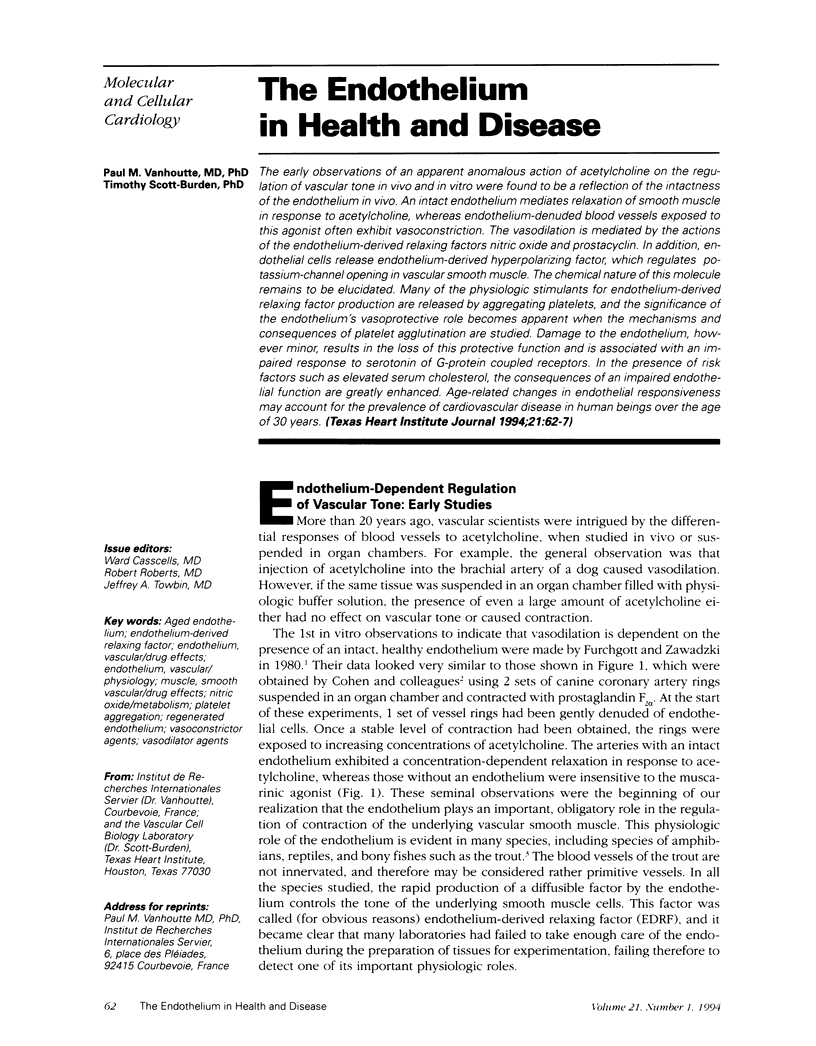
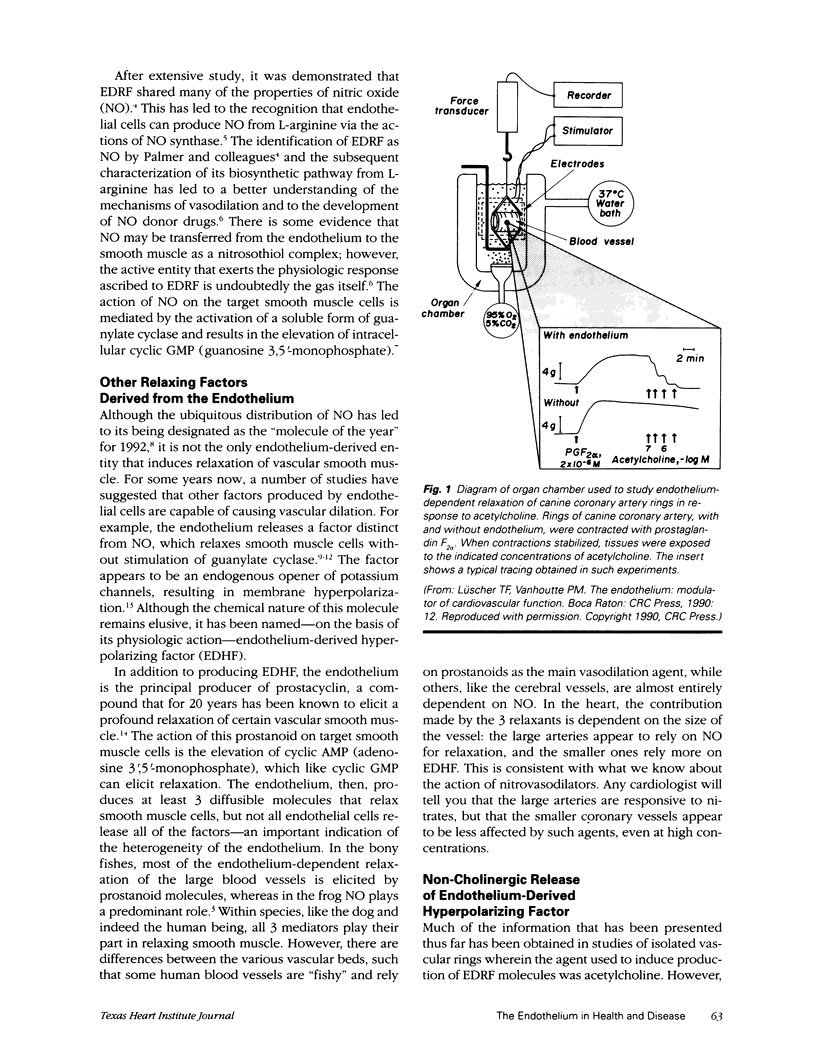
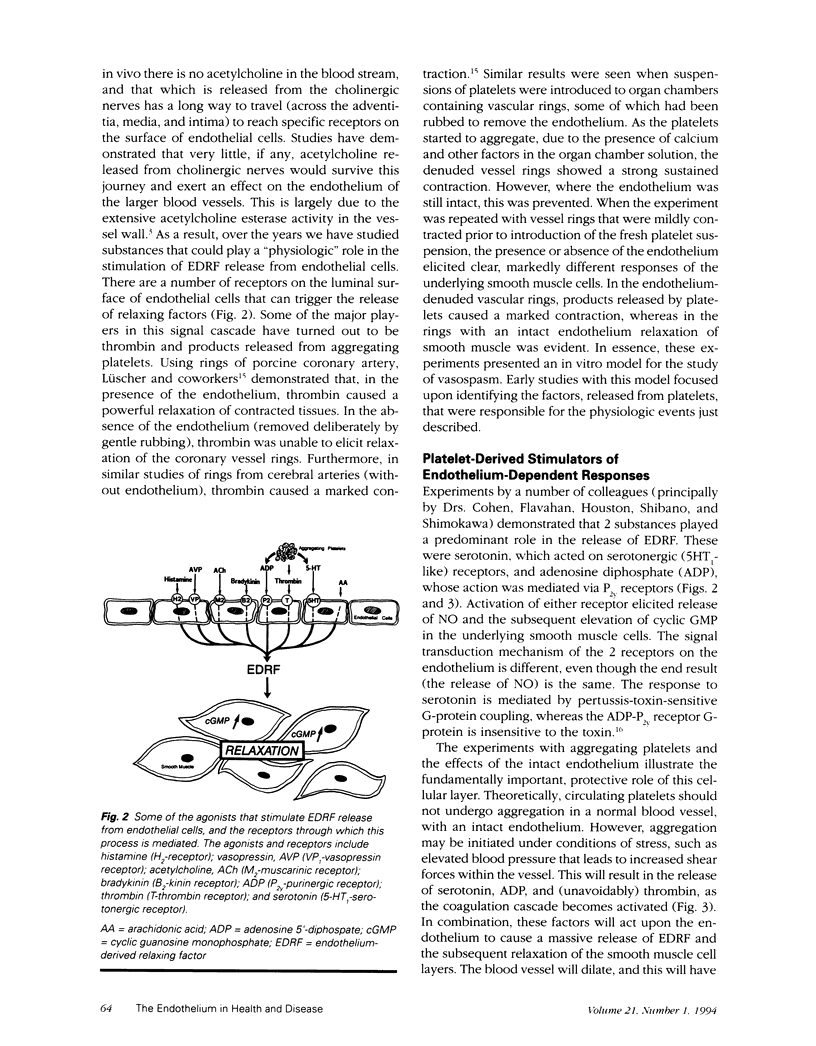
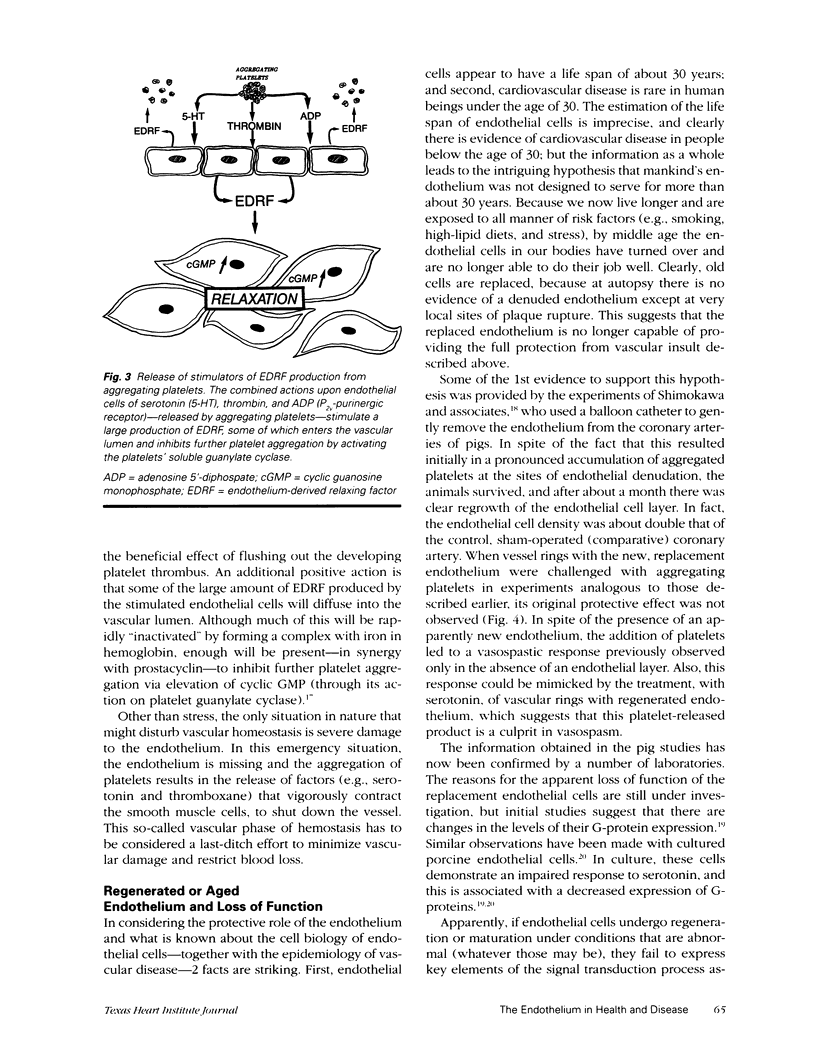
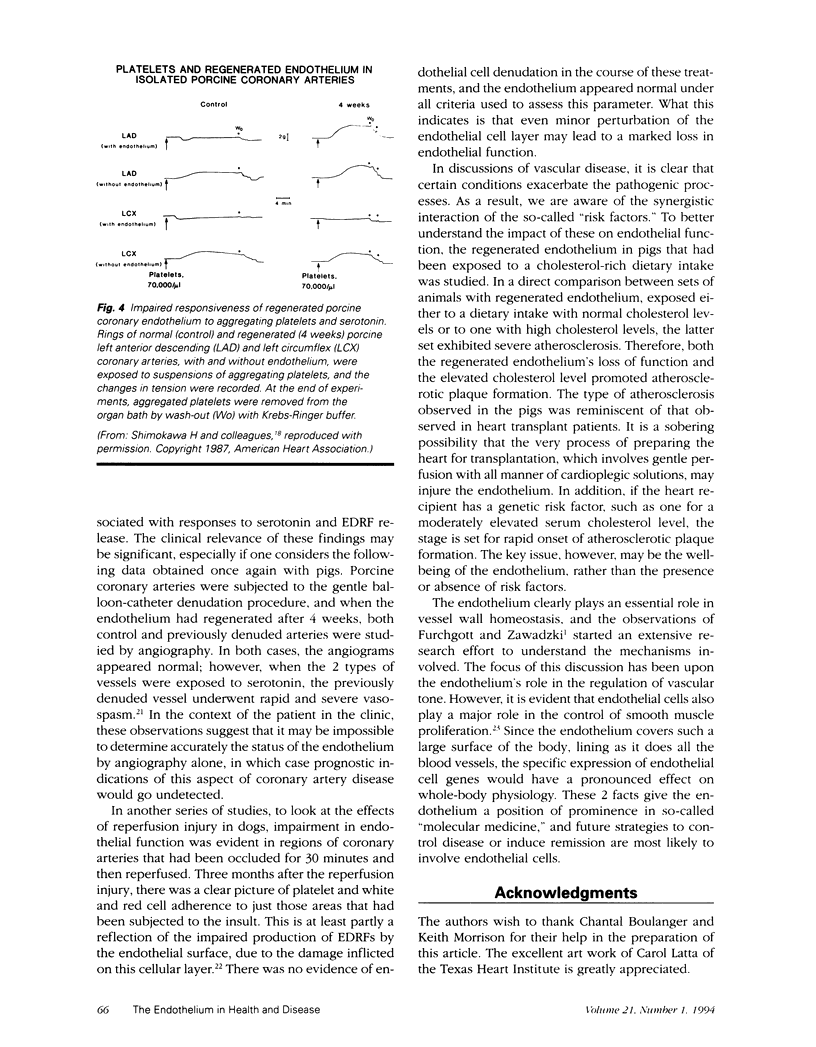
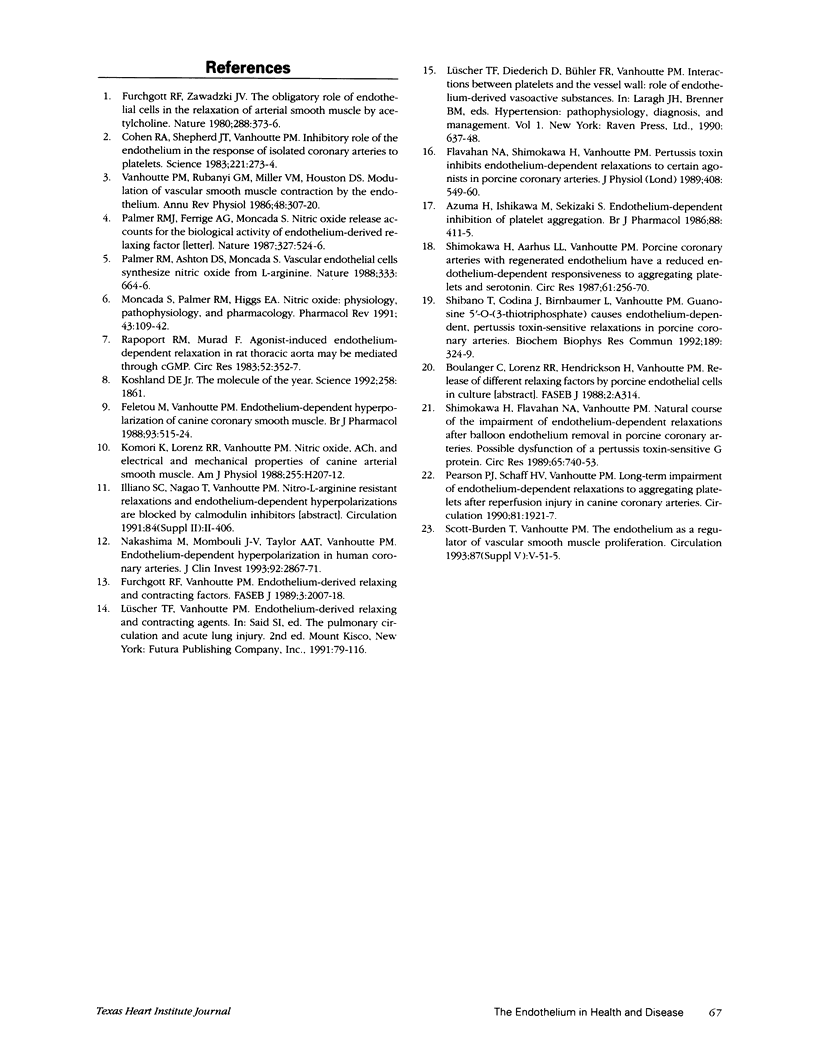
Selected References
These references are in PubMed. This may not be the complete list of references from this article.
- Azuma H., Ishikawa M., Sekizaki S. Endothelium-dependent inhibition of platelet aggregation. Br J Pharmacol. 1986 Jun;88(2):411–415. doi: 10.1111/j.1476-5381.1986.tb10218.x. [DOI] [PMC free article] [PubMed] [Google Scholar]
- Cohen R. A., Shepherd J. T., Vanhoutte P. M. Inhibitory role of the endothelium in the response of isolated coronary arteries to platelets. Science. 1983 Jul 15;221(4607):273–274. doi: 10.1126/science.6574604. [DOI] [PubMed] [Google Scholar]
- Feletou M., Vanhoutte P. M. Endothelium-dependent hyperpolarization of canine coronary smooth muscle. Br J Pharmacol. 1988 Mar;93(3):515–524. doi: 10.1111/j.1476-5381.1988.tb10306.x. [DOI] [PMC free article] [PubMed] [Google Scholar]
- Flavahan N. A., Shimokawa H., Vanhoutte P. M. Pertussis toxin inhibits endothelium-dependent relaxations to certain agonists in porcine coronary arteries. J Physiol. 1989 Jan;408:549–560. doi: 10.1113/jphysiol.1989.sp017475. [DOI] [PMC free article] [PubMed] [Google Scholar]
- Furchgott R. F., Vanhoutte P. M. Endothelium-derived relaxing and contracting factors. FASEB J. 1989 Jul;3(9):2007–2018. [PubMed] [Google Scholar]
- Furchgott R. F., Zawadzki J. V. The obligatory role of endothelial cells in the relaxation of arterial smooth muscle by acetylcholine. Nature. 1980 Nov 27;288(5789):373–376. doi: 10.1038/288373a0. [DOI] [PubMed] [Google Scholar]
- Komori K., Lorenz R. R., Vanhoutte P. M. Nitric oxide, ACh, and electrical and mechanical properties of canine arterial smooth muscle. Am J Physiol. 1988 Jul;255(1 Pt 2):H207–H212. doi: 10.1152/ajpheart.1988.255.1.H207. [DOI] [PubMed] [Google Scholar]
- Koshland D. E., Jr The molecule of the year. Science. 1992 Dec 18;258(5090):1861–1861. doi: 10.1126/science.1470903. [DOI] [PubMed] [Google Scholar]
- Moncada S., Palmer R. M., Higgs E. A. Nitric oxide: physiology, pathophysiology, and pharmacology. Pharmacol Rev. 1991 Jun;43(2):109–142. [PubMed] [Google Scholar]
- Nakashima M., Mombouli J. V., Taylor A. A., Vanhoutte P. M. Endothelium-dependent hyperpolarization caused by bradykinin in human coronary arteries. J Clin Invest. 1993 Dec;92(6):2867–2871. doi: 10.1172/JCI116907. [DOI] [PMC free article] [PubMed] [Google Scholar]
- Palmer R. M., Ashton D. S., Moncada S. Vascular endothelial cells synthesize nitric oxide from L-arginine. Nature. 1988 Jun 16;333(6174):664–666. doi: 10.1038/333664a0. [DOI] [PubMed] [Google Scholar]
- Palmer R. M., Ferrige A. G., Moncada S. Nitric oxide release accounts for the biological activity of endothelium-derived relaxing factor. Nature. 1987 Jun 11;327(6122):524–526. doi: 10.1038/327524a0. [DOI] [PubMed] [Google Scholar]
- Pearson P. J., Schaff H. V., Vanhoutte P. M. Long-term impairment of endothelium-dependent relaxations to aggregating platelets after reperfusion injury in canine coronary arteries. Circulation. 1990 Jun;81(6):1921–1927. doi: 10.1161/01.cir.81.6.1921. [DOI] [PubMed] [Google Scholar]
- Rapoport R. M., Murad F. Agonist-induced endothelium-dependent relaxation in rat thoracic aorta may be mediated through cGMP. Circ Res. 1983 Mar;52(3):352–357. doi: 10.1161/01.res.52.3.352. [DOI] [PubMed] [Google Scholar]
- Shibano T., Codina J., Birnbaumer L., Vanhoutte P. M. Guanosine 5'-O-(3-thiotriphosphate) causes endothelium-dependent, pertussis toxin-sensitive relaxations in porcine coronary arteries. Biochem Biophys Res Commun. 1992 Nov 30;189(1):324–329. doi: 10.1016/0006-291x(92)91561-4. [DOI] [PubMed] [Google Scholar]
- Shimokawa H., Aarhus L. L., Vanhoutte P. M. Porcine coronary arteries with regenerated endothelium have a reduced endothelium-dependent responsiveness to aggregating platelets and serotonin. Circ Res. 1987 Aug;61(2):256–270. doi: 10.1161/01.res.61.2.256. [DOI] [PubMed] [Google Scholar]
- Shimokawa H., Flavahan N. A., Vanhoutte P. M. Natural course of the impairment of endothelium-dependent relaxations after balloon endothelium removal in porcine coronary arteries. Possible dysfunction of a pertussis toxin-sensitive G protein. Circ Res. 1989 Sep;65(3):740–753. doi: 10.1161/01.res.65.3.740. [DOI] [PubMed] [Google Scholar]
- Vanhoutte P. M., Rubanyi G. M., Miller V. M., Houston D. S. Modulation of vascular smooth muscle contraction by the endothelium. Annu Rev Physiol. 1986;48:307–320. doi: 10.1146/annurev.ph.48.030186.001515. [DOI] [PubMed] [Google Scholar]


